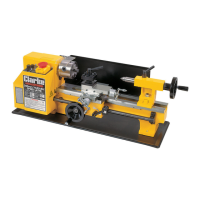17
Parts & Service: 020 8988 7400 / E-mail: Parts@clarkeinternational.com or Service@clarkeinternational.com
OPERATION
SIMPLE TURNING
Before starting the machine, it is imperative that the setup for the type of work
to be carried out is fully checked.
The following notes are guidelines as
to how to set up the lathe in order to
carry out a simple turning operation.
ALWAYS plan your work. Have
drawings or a plan on hand together
with any measuring instruments you
may require, such as micrometers/
verniers/calipers etc.
Select a cutting tool that will produce
the desired cut and mount it in the
Tool Rest, with as little overhang as
possible, securing it using three hex
socket head screws as shown in FIG. 6.
(Ideally, the overhang should be
approx. 10 mm but not more than 15mm for a straight tool).
It is essential that the tip of the cutting tool is on the centre line of the work or
very slightly below it. On no account should it be above the centre line. Where
necessary, shims should be used beneath the tool in order to achieve the
correct height, or, if the tip is too high, the only recourse is to select another
tool or grind down the tip.
To check to ensure the tip is at the correct height, position the tool so that the
tip is almost touching the point of the tailstock centre. They should coincide. If
necessary make adjustments using shims, grind down the cutting tool tip or
select another tool.
When satisfied, mount the work, either in the chuck or on a faceplate, and if
necessary, use the tailstock centre for additional support (If the work cannot
be adequately secured by the chuck, or if it is a long piece, or of small
diameter). Additionally, ‘Steadies’ may be used which are described in
greater detail under ‘Accessories’.
If the tailstock is not to be used you may remove it completely by slackening
off the securing nut at its base and sliding it free of the bed.
Mark the surface of the work at the point where the cut is to end, i.e. the
shoulder, using a scriber or similar means, and move the saddle so that the
cutting tool is directly opposite the mark, then wind in the cross-slide so that
the tool touches the surface of the work.

